Neuroendocrine tumours of the appendix
Authors:
O. Louthan
Authors‘ workplace:
Ambulance pro neuroendokrinní nádory IV. interní kliniky 1. lékařské fakulty UK a VFN Praha, přednosta prof. MU Dr. Aleš Žák, DrSc.
Published in:
Vnitř Lék 2009; 55(11): 1051-1055
Category:
Reviews
Overview
According to WHO, neuroendocrine tumors of the appendix (appendiceal carcinoids) are defined as 1. well‑differentiated endocrine tumors with benign or uncertain behavior, 2. well‑differentiated endocrine carcinoma and 3. goblet cell carcinoma. These tumors are usually diagnosed incidentally during appendectomy. Carcinoid syndrome is rare in appendiceal carcinoid. Tumor size greater than 2 cm is the most important parameter for prognosis. Most patients are cured by appendectomy (appendiceal tumors ≤ 2 cm), tumors with a diameter > 2 cm should be managed by right hemicolectomy.
Key words:
goblet cell carcinoid – hemicolectomy – neuroendocrine tumor – WHO classification
Sources
1. Glazebrook L. Case of endothelial sarcomata of vermiform appendix. Virg Med Month 1895; xxii: 211.
2. Williams ED, Sandler M. The classification of carcinoid tumours. Lancet 1963; 1: 238– 239.
3. Solcia E, Klöppel G, Sobin LH. Histological Typing of Endocrine Tumours. 2nd ed. In: WHO. International Histological Classification of Tumours. Berlin, New York: Springer 2000.
4. Modlin IM, Kidd M, Latich I et al. Current status of gastrointestinal carcinoids. Gastroenterology 2005; 128: 1717– 1751.
5. McCusker ME, Cote TR, Clegg LX et al. Primary malignant neoplasms of the appendix: a population‑based study from the surveillance, epidemiology and end‑results program 1973– 1998. Cancer 2002; 94: 3307– 3312.
6. Modlin IM, Lye KD, Kidd M. A five‑ decade analysis of 13,715 carcinoid tumors. Cancer 2003; 97: 934– 959.
7. Van Eeden S, Quaedvlieg PF, Taal BG et al. Classification of low‑ grade neuroendocrine tumors of midgut and unknown origin. Hum Pathol 2002; 33: 1126– 1132.
8. Klöppel G, Rindi G, Anlauf M et al. Site- specific biology and pathology of gastroenteropancreatic neuroendocrine tumors. Virchows Arch 2007; 451 (Suppl 1): S9– S27.
9. Goddard MJ, Lonsdale RN. The histogenesis of appendiceal carcinoid tumours. Histopathology 1992; 20: 345– 349.
10. Shaw PA. The topographical and age distribution of neuroendocrine cells in the normal appendix. J Pathol 1991; 164: 235– 239.
11. Rindi G, Klöppel G, Couvelard A et al. TNM staging of midgut and hindgut (neuro) endocrine tumors: a consensus proposal including a grading system. Virchows Arch 2007; 451: 757– 762.
12. Chiti A, Fanti S, Savelli G et al. Comparison of somatostatin receptor imaging, computed tomography and ultrasound in the clinical management of neuroendocrine gastroenteropancreatic tumours. Eur J Nucl Med 1998; 25: 1396– 1403.
13. Dromain C, de Baere T, Lumbroso J et al. Detection of liver metastases from endocrine tumours: a prospective comparison of somatostatin receptor scintigraphy, computed tomography, and magnetic resonance imaging. J Clin Oncol 2005; 23: 70– 78.
14. Pickhardt PJ, Levy AD, Rohrmann CA jr et al. Primary neoplasms of the appendix: radiologic spectrum of disease with pathologic correlation. Radiographics 2003; 23: 645– 662.
15. Ramage JK, Davies AH, Ardill J et al. Guidelines for the management of gastroenteropancreatic neuroendocrine (including carcinoid) tumours. Gut 2005; 54 (Suppl IV): iv1– iv16.
16. Varisco B, McAlvin B, Dias J et al. Adenocarcinoid of the appendix: is right hemicolectomy necessary? A meta‑analysis of retrospective chart reviews. Am Surg 2004; 70: 593– 599.
17. Safioleas MC, Moulakakis KG, Kontzoglou K et al. Carcinoid tumors of the appendix. Prognostic factors and evaluation of indications for right hemicolectomy. Hepatogastroenterology 2005; 52: 123– 127.
18. Plöckinger U, Couvelard A, Falconi M et al. Consensus Guidelines for the Management of Patients with Digestive Neuroendocrine Tumours: Well‑differentiated Tumour/ Carcinoma of the Appendix and Goblet Cell Carcinoma. Neuroendocrinology, ENETS Consensus Guidelines for the Diagnosis and Treatment of Neuroendocrine Gastrointestinal Tumors. Part 2 – Midgut and Hindgut Tumors. Neuroendocrinology 2008; 87: 20– 30.
19. Ahlman H, Wängberg B, Jansson S et al. Interventional Treatment of Gastrointestinal Neuroendocrine Tumours. Digestion 2000; 62 (Suppl 1): 59– 68.
20. Goede AC, Caplin ME, Winslet MC. Carcinoid tumour of the appendix. Br J Surg 2003; 90: 1317– 1322.
21. Caplin ME, Buscombe JR, Hilson AJ et al. Carcinoid tumour. Lancet 1998; 352: 799– 805.
22. Barakat MT, Meeran K, Bloom SR. Neuroendocrine tumours. Endocr Relat Cancer 2004; 11: 1– 18.
23. Moertel CG, Weiland LH, Nagorney DM et al. Carcinoid tumor of the appendix: treatment and prognosis. N Engl J Med 1987; 317: 1699– 1701.
24. Tiensuu Janson EM, Öberg KE. Carcinoid tumours. Baillieres Clin Gastroenterol 1996; 10: 589– 601.
25. Rouanet P, Saingra B, Simony‑ Lafontaine J et al. Prognostic factors of carcinoid tumor of the appendix smaller than two centimeters. Surgery 1993; 113: 595.
26. Sandor A, Modlin IM. A retrospective analysis of 1,570 appendiceal carcinoids. Am J Gastroenterol 1998; 93: 422– 428.
Labels
Diabetology Endocrinology Internal medicineArticle was published in
Internal Medicine

2009 Issue 11
Most read in this issue
- Neuroendocrine tumours of the appendix
- Recurrent unsustained ventricular tachycardia in pregnancy
- Endoscopic diagnostics and management of pancreatic- biliary disorders in patients after Billroth II gastric resection
- Repeated local thrombolysis in a patient with axillary and subclavian vein injury and thrombosis
